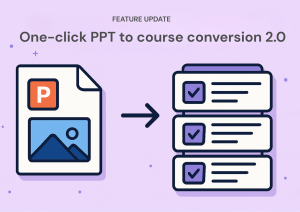
Employee Education: Strategies to Empower Your Workforce with AI-Powered Learning
- Author: Urban Rotar
- Published:
Discover how employee education enhances productivity and retention. Learn how Coursly.ai’s AI-powered tools revolutionize corporate training.
Employee education is more than just corporate training—it’s a strategic approach to continuously developing your workforce’s skills, knowledge, and capabilities. In today’s fast-paced, tech-driven world, companies that invest in modern, AI-powered education tools are seeing measurable improvements in productivity, engagement, and retention. This article explores how businesses can implement effective employee education programs and how platforms like Coursly.ai and Smart Arena are reshaping the way organizations train and empower their teams.
What Is Employee Education and Why It Matters
Defining Employee Education in the Modern Workplace
Employee education encompasses structured learning initiatives aimed at enhancing employees’ skills, knowledge, and competencies. Unlike traditional training, which often focuses on immediate job requirements, employee education takes a broader approach, preparing individuals for future roles and challenges. This proactive strategy is essential in today’s rapidly evolving business landscape, where continuous learning is key to organizational success.
Employee Education vs. Training vs. Development
While often used interchangeably, these terms have distinct meanings:
- Training: Short-term, role-specific instruction designed to improve performance in current tasks.
- Development: Long-term growth opportunities aimed at preparing employees for future roles.
- Education: A comprehensive approach that combines both training and development, fostering a culture of continuous learning.
The Rise of Digital and AI-Driven Learning Solutions
The digital transformation has revolutionized employee education. AI-powered platforms like Coursly.ai enable organizations to create personalized, scalable, and efficient learning experiences. By leveraging existing materials, such as PowerPoint presentations and documents, these tools can rapidly generate interactive courses, reducing the time and resources traditionally required for content development.
The Business Benefits of Employee Education
Closing Skills Gaps and Boosting Productivity
Investing in employee education helps organizations address skill shortages and adapt to technological advancements. By equipping employees with the necessary competencies, businesses can enhance productivity and maintain a competitive edge.
Improving Employee Engagement and Satisfaction
Providing learning opportunities demonstrates a company’s commitment to its workforce, leading to increased job satisfaction and engagement. Employees who feel valued and supported are more likely to contribute positively to the organization‘s goals.
Enhancing Retention and Reducing Turnover
Continuous education fosters employee loyalty. When individuals see opportunities for growth within their organization, they are less likely to seek employment elsewhere, reducing turnover rates and associated costs.
Aligning Workforce Growth with Business Goals
Strategic employee education ensures that workforce development aligns with organizational objectives. By tailoring learning initiatives to business needs, companies can drive performance and achieve long-term success.

Common Types of Employee Education Programs
- Onboarding: Helps new hires integrate quickly and understand company culture.
- Compliance Training: Ensures employees follow legal and industry regulations.
- Leadership Development: Prepares future leaders with key management skills.
- Technical Training: Builds job-specific knowledge and capabilities.
- Soft Skills Training: Improves communication, teamwork, and adaptability.
How to Build an Effective Employee Education Strategy
Assessing Organizational Needs and Skills Gaps
Conduct thorough assessments to identify areas where skill development is needed, ensuring that education programs address actual gaps.
Setting Clear Learning Objectives and KPIs
Define specific, measurable goals for education initiatives to track progress and evaluate effectiveness.
Choosing the Right Delivery Methods
Select appropriate formats—such as e-learning, workshops, or blended learning—to suit the content and audience.
Creating a Culture of Continuous Learning
Encourage ongoing development by integrating learning into daily workflows and recognizing achievements, fostering an environment where education is valued.
Case Studies: How Coursly.ai Transformed Learning at Leading Companies
1. Boosting Training Efficiency and Reducing Time-to-Competency
Organizations utilizing Coursly.ai have reported significant reductions in training time, enabling employees to reach proficiency more quickly.
2. Increasing Engagement with Personalized Learning Paths
By offering customized learning experiences, companies have seen higher engagement rates and improved knowledge retention among employees.
3. Achieving Measurable ROI on Employee Education
Investments in Coursly.ai have led to tangible returns, including increased productivity, reduced turnover, and enhanced employee satisfaction.
Why Now Is the Time to Rethink Employee Education
As workplace demands and technologies continue to shift at a record pace, rethinking employee education has become a strategic necessity. Equipping your team with the right tools, knowledge, and learning opportunities ensures they remain adaptable, engaged, and productive. With innovative platforms like Coursly.ai and Smart Arena, businesses can deliver personalized, scalable, and AI-powered learning experiences that align with their goals and future-proof their workforce.
Now is the time to invest in smarter employee education strategies that empower people and drive long-term success.



